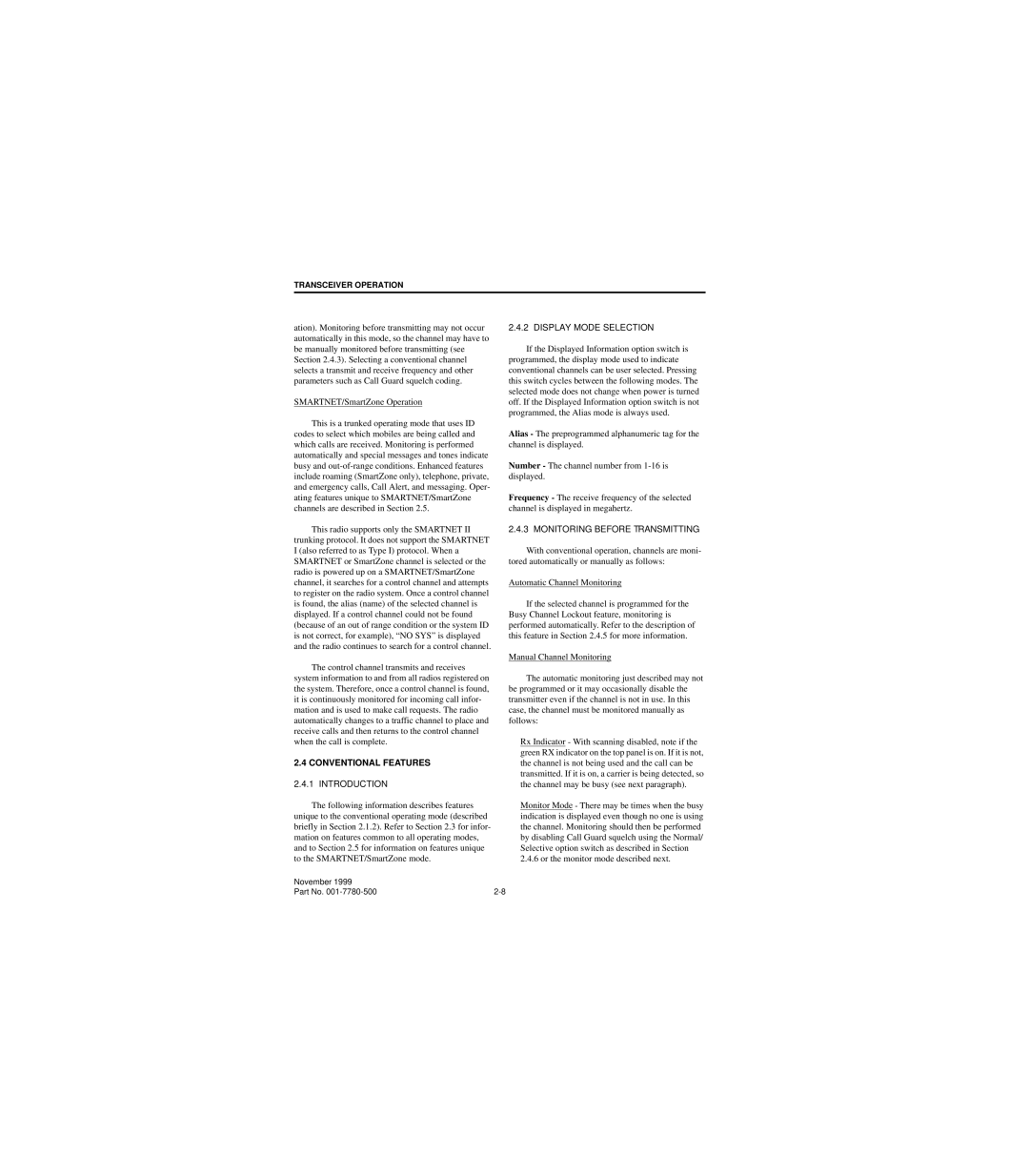TRANSCEIVER OPERATION
ation). Monitoring before transmitting may not occur automatically in this mode, so the channel may have to be manually monitored before transmitting (see Section 2.4.3). Selecting a conventional channel selects a transmit and receive frequency and other parameters such as Call Guard squelch coding.
SMARTNET/SmartZone Operation
This is a trunked operating mode that uses ID codes to select which mobiles are being called and which calls are received. Monitoring is performed automatically and special messages and tones indicate busy and
This radio supports only the SMARTNET II trunking protocol. It does not support the SMARTNET I (also referred to as Type I) protocol. When a SMARTNET or SmartZone channel is selected or the radio is powered up on a SMARTNET/SmartZone channel, it searches for a control channel and attempts to register on the radio system. Once a control channel is found, the alias (name) of the selected channel is displayed. If a control channel could not be found (because of an out of range condition or the system ID is not correct, for example), “NO SYS” is displayed and the radio continues to search for a control channel.
The control channel transmits and receives system information to and from all radios registered on the system. Therefore, once a control channel is found, it is continuously monitored for incoming call infor- mation and is used to make call requests. The radio automatically changes to a traffic channel to place and receive calls and then returns to the control channel when the call is complete.
2.4 CONVENTIONAL FEATURES
2.4.1 INTRODUCTION
The following information describes features unique to the conventional operating mode (described briefly in Section 2.1.2). Refer to Section 2.3 for infor- mation on features common to all operating modes, and to Section 2.5 for information on features unique to the SMARTNET/SmartZone mode.
2.4.2 DISPLAY MODE SELECTION
If the Displayed Information option switch is programmed, the display mode used to indicate conventional channels can be user selected. Pressing this switch cycles between the following modes. The selected mode does not change when power is turned off. If the Displayed Information option switch is not programmed, the Alias mode is always used.
Alias - The preprogrammed alphanumeric tag for the channel is displayed.
Number - The channel number from
Frequency - The receive frequency of the selected channel is displayed in megahertz.
2.4.3 MONITORING BEFORE TRANSMITTING
With conventional operation, channels are moni- tored automatically or manually as follows:
Automatic Channel Monitoring
If the selected channel is programmed for the Busy Channel Lockout feature, monitoring is performed automatically. Refer to the description of this feature in Section 2.4.5 for more information.
Manual Channel Monitoring
The automatic monitoring just described may not be programmed or it may occasionally disable the transmitter even if the channel is not in use. In this case, the channel must be monitored manually as follows:
Rx Indicator - With scanning disabled, note if the green RX indicator on the top panel is on. If it is not, the channel is not being used and the call can be transmitted. If it is on, a carrier is being detected, so the channel may be busy (see next paragraph).
Monitor Mode - There may be times when the busy indication is displayed even though no one is using the channel. Monitoring should then be performed by disabling Call Guard squelch using the Normal/ Selective option switch as described in Section 2.4.6 or the monitor mode described next.
November 1999 |
|
Part No. |
